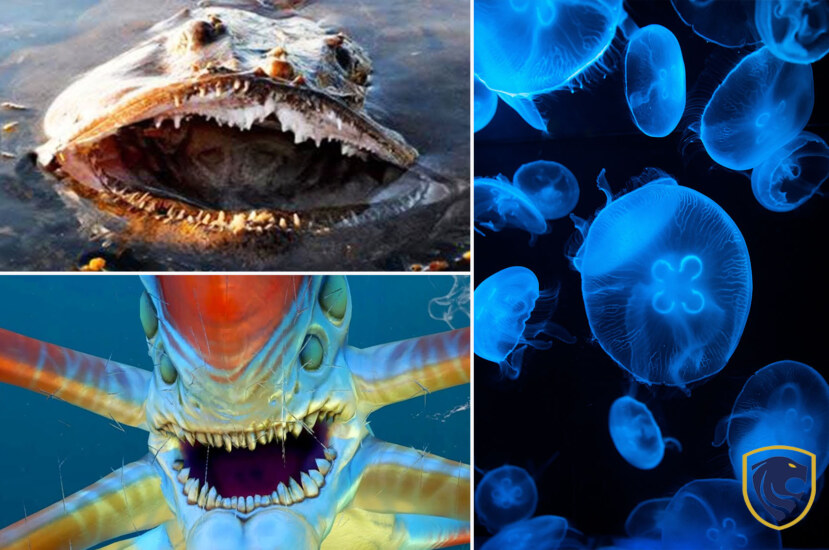Numerous species inhabit the ocean. Some of which have powerful abilities that make them extremely deadly. These organisms have developed poisonous tentacles and razor-sharp teeth to survive and prosper in their aquatic surroundings. The risk they represent to people and their distinctive traits will be highlighted as we examine the most deadly marine life.
Box jellyfish (Chironex fleckeri)
The Box jellyfish, scientifically known as Chironex fleckeri, is an extremely dangerous creature found in the ocean. It possesses long, tentacle-like appendages lined with venomous cells called nematocysts. Each tentacle can be up to 10 feet long, making it a formidable threat. Furthermore, the Box jellyfish’s venom is very strong, quick-acting, and includes toxins that attack the heart, neurological system, and skin cells. A single sting can cause excruciating pain, paralysis, and in severe cases, even death.
What makes the Box jellyfish particularly perilous is its nearly transparent body, making it difficult to spot in the water. This makes accidental encounters with swimmers and divers, increasing the risk of stings. Victims of Box jellyfish stings may experience immediate symptoms such as intense pain, redness, and swelling. In severe cases, the venom can cause cardiac arrest or interfere with the victim’s ability to breathe, leading to drowning.

Box jellyfish (Chironex fleckeri); Most Dangerous Creatures In The Ocean
Although the Box jellyfish is most commonly found in the waters of the Pacific and Indian Oceans, it is crucial to be cautious in any region where they may inhabit. It is advised to wear protective clothing, such as stinger suits, and to be aware of jellyfish warning signs when swimming or diving in known jellyfish habitats. Encountering a Box jellyfish requires immediate medical attention, and it is vital to seek professional help for proper treatment. Prevention, awareness, and swift action are key in mitigating the dangers posed by this treacherous creature.
Great white shark (Carcharodon carcharias)
Carcharodon carcharias is the scientific name for the great white shark. It is among the most dreaded and harmful marine life. It has earned an enviable standing as a fearsome predator. With its massive size, powerful jaws, and rows of sharp, serrated teeth, the Great white shark is built for hunting and capturing prey. They may weigh several thousand pounds and reach lengths of up to 20 feet. Great white sharks are known for their exceptional speed and agility, capable of reaching speeds up to 35 miles per hour. This makes them highly efficient hunters, capable of launching sudden, powerful attacks on their prey.

Great white shark (Carcharodon carcharias); Most Dangerous Creatures In The Ocean
Although humans are not their preferred prey, Great white sharks can mistake swimmers or surfers for seals or other marine mammals, leading to occasional attacks. These attacks can result in severe injuries or even fatalities. With their keen noses, great white sharks can smell blood from kilometers away. Also, their ability to detect electromagnetic fields generated by the movement of living organisms further enhances their hunting prowess.
Their presence near popular beaches and surf spots can instill fear and apprehension among beachgoers. It is crucial to remember that these kinds of attacks are uncommon and that most interactions with great white sharks are not dangerous. In order to preserve the balance of marine ecosystems, efforts are made to research and conserve these amazing species. So, responsible conservation measures and public awareness can help ensure coexistence with this powerful predator.
Saltwater crocodile (Crocodylus porosus)
The saltwater crocodile, or Crocodylus porosus as it is named technically, is a fierce and dangerous animal. It may be found along the Indo-Pacific coast. With its immense size, powerful jaws, and a reputation for aggressive behavior, the Saltwater crocodile is considered the largest living reptile on Earth. Moreover, the male adults can grow up to 23 feet in length. They are also the top predators in their ecosystem since they may weigh more than a tonne.
These crocodiles are renowned for having superb swimming skills. As a result, they may be found in both freshwater and saltwater ecosystems, such as rivers, estuaries, and mangrove swamps. Being opportunistic hunters, saltwater crocodiles have been known to attack and eat a variety of food, including fish, birds, mammals, and even other crocodiles. Their ambush-hunting technique and lightning-fast strikes make them incredibly dangerous to any creature that ventures too close to the water’s edge.

Saltwater crocodile (Crocodylus porosus); Most Dangerous Creatures In The Ocean
Humans are not exempt from their predatory behavior, and Saltwater crocodile attacks on people are documented, often resulting in severe injuries or fatalities.
Due to their aggressive nature and territorial behavior, caution is essential when navigating waters inhabited by Saltwater crocodiles. Conservation efforts and awareness campaigns play a crucial role in promoting coexistence with these ancient and powerful creatures.
Portuguese man o’ war (Physalia physalis)
The scientific name for the Portuguese man o war is Physalia Physalis. It is a very hazardous aquatic animal that is sometimes confused with a jellyfish. But in reality, it is a siphonophore. It comprises a transparent, inflated balloon-like floating gas-filled bladder with protruding long tentacles. The Portuguese man of war has tentacles that may reach a maximum length of 165 feet. It also possesses poisonous cells known as nematocysts. These tentacles have a strong sting that may be quite painful. Additionally, it can be fatal, particularly for people with allergies or other sensitivities. Encounters with the Portuguese man o’ war commonly occur when they are washed ashore or when swimmers unknowingly come into contact with their trailing tentacles in the water.

Portuguese man o’ war (Physalia physalis); Most Dangerous Creatures In The Ocean
Even detached tentacles can retain their venom and pose a threat. The creature is known for its ability to deliver a painful sting long after it appears to be dead or decaying.
It is important to exercise caution and keep a safe distance from stranded Portuguese man o’ war. Immediate medical attention is necessary in case of a sting to minimize the risk of severe allergic reactions or other complications.
Blue-ringed octopus (Hapalochlaena spp.)
The genus Hapalochlaena includes the hazardous and poisonous blue-ringed octopus, which is a marine animal. Despite being little, it normally measures between 4 and 8 inches. One of the most poisonous marine organisms is the blue-ringed octopus. The vivid blue rings that develop on its body when it feels threatened or disturbed are where it gets its name. The blue-ringed octopus venom includes potent neurotoxins.

Blue-ringed octopus (Hapalochlaena spp.); Most Dangerous Creatures In The Ocean
It can paralyze its prey and pose a significant risk to humans. Also, their bites are often painless and can go unnoticed, making them even more dangerous as victims may not seek immediate medical attention. Within minutes, the venom can cause muscle weakness, difficulty breathing, vision problems, and eventually, respiratory failure. Encounters with the Blue-ringed octopus commonly occur in shallow tidal pools or coral reefs, where they blend in with their surroundings.
Due to their small size and docile appearance, they can be mistaken as harmless, increasing the risk of accidental contact. It is crucial to exercise extreme caution and avoid handling or disturbing these creatures, as their venom can be fatal. Prompt medical treatment is vital in case of a Blue-ringed octopus bite to minimize the potentially life-threatening effects of the venom.




